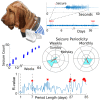Circadian and multiday seizure periodicities, and seizure clusters in canine epilepsy
- PMID: 32161910
- PMCID: PMC7052793
- DOI: 10.1093/braincomms/fcaa008
Circadian and multiday seizure periodicities, and seizure clusters in canine epilepsy
Abstract
Advances in ambulatory intracranial EEG devices have enabled objective analyses of circadian and multiday seizure periodicities, and seizure clusters in humans. This study characterizes circadian and multiday seizure periodicities, and seizure clusters in dogs with naturally occurring focal epilepsy, and considers the implications of an animal model for the study of seizure risk patterns, seizure forecasting and personalized treatment protocols. In this retrospective cohort study, 16 dogs were continuously monitored with ambulatory intracranial EEG devices designed for humans. Detailed medication records were kept for all dogs. Seizure periodicity was evaluated with circular statistics methods. Circular non-uniformity was assessed for circadian, 7-day and approximately monthly periods. The Rayleigh test was used to assess statistical significance, with correction for multiple comparisons. Seizure clusters were evaluated with Fano factor (index of dispersion) measurements, and compared to a Poisson distribution. Relationships between interseizure interval (ISI) and seizure duration were evaluated. Six dogs met the inclusion criteria of having at least 30 seizures and were monitored for an average of 65 weeks. Three dogs had seizures with circadian seizure periodicity, one dog had a 7-day periodicity, and two dogs had approximately monthly periodicity. Four dogs had seizure clusters and significantly elevated Fano factor values. There were subject-specific differences in the dynamics of ISI and seizure durations, both within and between lead and clustered seizure categories. Our findings show that seizure timing in dogs with naturally occurring epilepsy is not random, and that circadian and multiday seizure periodicities, and seizure clusters are common. Circadian, 7-day, and monthly seizure periodicities occur independent of antiseizure medication dosing, and these patterns likely reflect endogenous rhythms of seizure risk.
Keywords: EEG; ambulatory EEG; animal models; epilepsy; intracranial EEG; seizure prediction.
© The Author(s) (2020). Published by Oxford University Press on behalf of the Guarantors of Brain.
Figures






References
-
- Abou-Khalil B, Wheless J, Rogin J, Wolter KD, Pixton GC, Shukla RB, et al. A double-blind, randomized, placebo-controlled trial of a diazepam auto-injector administered by caregivers to patients with epilepsy who require intermittent intervention for acute repetitive seizures. Epilepsia 2013; 54: 1968–76. - PubMed
-
- Almagor M, Ehrlich S.. Personality correlates and cyclicity in positive and negative affect. PR 1990; 66: 1159–69. - PubMed
-
- Aschoff J. Circadian rhythms in man. Science 1965; 148: 1427–32. - PubMed
-
- Baud MO, Ghestem A, Benoliel JJ, Becker C, Bernard C.. Endogenous multidien rhythm of epilepsy in rats. Exp Neurol 2019; 315: 82–7. - PubMed
Grants and funding
LinkOut - more resources
Full Text Sources
Miscellaneous
